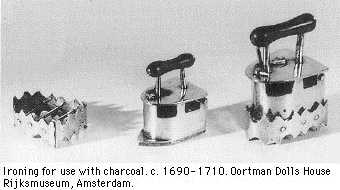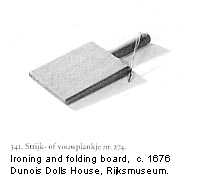 An
ironing iron, 'een yser stryckyser' in the back kitchen., room J.
An
ironing iron, 'een yser stryckyser' in the back kitchen., room J. An
ironing iron, 'een yser stryckyser' in the back kitchen., room J.
An
ironing iron, 'een yser stryckyser' in the back kitchen., room J.
The iron was heated by putting hot coals or charcoal in the hold.
The ironing was done on a small ironing plank. The example below is made from a single piece of wood.
Note : This object was part of the Vermeer-inventory as listed by the clerk working for the Delft notary public J. van Veen on February 29, 1676, in the Thins/Vermeer home located on Oude Langendijk on the corner of Molenpoort. The painter Johannes Vermeer had died there at the end of December 1675. His widow Catherina and their eleven children still lived there with her mother Maria Thins.
 The
transcription of the 1676 inventory, now in the Delft archives, is
based upon its first full publication by A.J.J.M. van Peer, "Drie
collecties..." in Oud Holland 1957, pp. 98-103. My additions
and explanations are added within square brackets [__]. Dutch
terms have been checked against the world's largest language
dictionary, the Dictionary of the Dutch Language (Woordenboek der
Nederlandsche Taal , or WNT), which was begun by De Vries
en Te Winkel in 1882. In 2001 many textile terms have been kindly
explained by art historian Marieke te Winkel.
The
transcription of the 1676 inventory, now in the Delft archives, is
based upon its first full publication by A.J.J.M. van Peer, "Drie
collecties..." in Oud Holland 1957, pp. 98-103. My additions
and explanations are added within square brackets [__]. Dutch
terms have been checked against the world's largest language
dictionary, the Dictionary of the Dutch Language (Woordenboek der
Nederlandsche Taal , or WNT), which was begun by De Vries
en Te Winkel in 1882. In 2001 many textile terms have been kindly
explained by art historian Marieke te Winkel.
Illustration taken from the recently published handbook on Dutch Doll Houses by Jet Pijzel-Dommisse,Het Hollandse pronkpoppenhuis, Interieur en huishouden in de 17de en 18de eeuw, Waanders, Zwolle; Rijksmuseum, Amsterdam, 2000, ill. 298, 341.
This page forms part of a large encyclopedic site on Vermeer and Delft. Research by Drs. Kees Kaldenbach (email). A full presentation is on view at johannesvermeer.info.
Launched December, 2002; Last update March 2, 2017.
Back to the Welcome page: click Welcome.